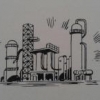|
|
Viscous Fluid Cooler
#1

Posted 19 September 2016 - 02:35 PM
I'm working on a project in which viscous fuel oil needs to be cooled to a low temperature and hence high viscosity. The vendor has proposed a shell and tube exchanger with the fuel in the shell side and cooling water in tube side. After I reviewed thier thermal package I noticed that: the flow is laminar in the shell side ( Re is in the range of 1000), flow fraction B is about 50% while flow fraction E is 30% approximately, allowable shell side pressure drop is 30% utilized while it is fully utilized in the tube side, the exchanger is six tube passes and the baffles are single segmental. I felt that the exchanger was not optimized from the thermal performance analysis, so I regected the proposal.
My question is: what modifications and enhancements can I simulate (using HTRI) to improve this exchanger?
Also, from your experience what other types of heat exchanger are suitable for such service?
Regards,
#2

Posted 20 September 2016 - 10:15 AM
What TEMA description did the vendor quote?
Edited by srfish, 20 September 2016 - 10:16 AM.
#3

Posted 20 September 2016 - 11:29 AM
AES type
#4

Posted 20 September 2016 - 01:54 PM
That is a good cleanable type.
#5

Posted 21 September 2016 - 06:09 PM
Because you have a viscous shell side fluid, reduce the clearance between the shell and the baffles to lower your E stream bypassing. Examine the effect of increasing the baffle pitch and the effect of increasing the baffle cut on the overall performance of the exchanger since this will also reduce the flow of the E stream. Vibration will not be a problem with a viscous fluid, so you consider also increasing the clearance between the baffles and tubes. The goal is still to reduce the flow of the E stream which is not useful to the heat transfer. HTRI allows you to monitor the overall effects of each of these changes individually so don't make every change at once. You are looking for an optimal combination to try to reduce your E flow by half at least. If these things do not give enough improvement, your best option is to look at using two exchangers in series since you have plenty of shell-side pressure drop available. The two-exchanger design will have smaller shell diameters and each exchanger will have lower shell-side temperature change which should help significantly. The installation will likely cost more with two units even though the overall surface area will be reduced, but this may still be a better fit for the service.
#6

Posted 22 September 2016 - 10:55 PM
Vegeta,
If you have a bit of time, please review the chapter 13: "Shell-and-tube Exchangers-the Pitfalls of Oversizing", of the book Process Design for Reliable Operations by Norman Lieberman.
On the other hand, you can take in account the BKU exchanger always in function of the operational variables and safety.
Napo.
#7

Posted 18 October 2016 - 09:11 AM
Dear,
For viscous fluids, the best is to get a unique single channel. Then SPHE from NEXSON GROUP (Spiral Heat Exchanger) solve laminar flow issue you get in a S&T.
This technology gets turbulent flow all long spiral core it will definetely improve your thermal efficiency. As a consequence much much more compact HTA than you the proposal you got.
Spiral Heat Exchanger is part of HTRI models, by HTRI doesn't provide full design, they offer you the posibility to check by yourself a quotation.
I advice to contact us on @ : http://www.nexson-gr..._9_lang_uk.html
Or you can email me in private.
Guillaume
Similar Topics
Time Required To Heat Up A Fluid In A VesselStarted by Guest_panagiotis_* , 24 Jan 2023 |
|

|
||
Air-Cooler Heat Exchanger - Unit Vs BayStarted by Guest_pymorty_* , 19 Dec 2023 |
|

|
||
Recommended Velocity For Highly Viscous Liquid In A PipeStarted by Guest_Quimarah_* , 13 Oct 2023 |
|

|
||
Dry Cooler Vs Cooling TowerStarted by Guest_Quimarah_* , 10 Sep 2023 |
|

|
||
Excel Based Calculator For Fluid Bed DryersStarted by Guest_outcast_* , 15 Mar 2023 |
|

|

 FB
FB










